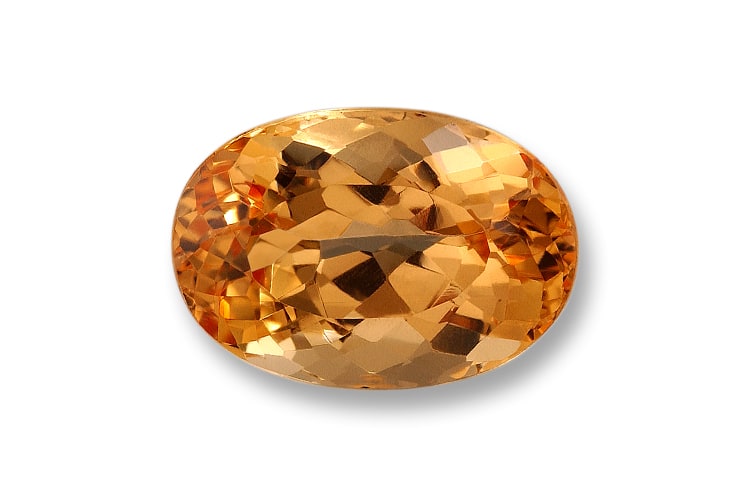Guide to Topaz

History, Lore and Appreciation
There is an unmistakable characteristic about the color of imperial topaz: a deep pink orange verging on red. While some enthusiasts considered golden color the classic color, pink to reddish orange hues are more highly desired today. Pablo Neruda, the Chilean poet, likened topaz to honey:
I invite you to a topaz.
To the honeycomb of yellow stone, To its bees,
To the frozen honey of a topaz,
To its golden day…
Origin of the word topaz is quite mysterious as it was once reserved for greenish gemstones – most likely peridots. Topazos is Greek in origin, and refers to the gems from the island of “Topazios,” which is known today as Zabargad. However, that Red Sea island is identified as the classic source of peridot. Dating back to Pliny the Elder’s time, topazos was described as a gem the color of fresh green olive oil. Slowly, over time, other colors were included within the definition of topazos, including yellowish gems. It was not until the 11th Century that the name began to clearly point to a yellow or golden color. Scholars suggest that this definition could have encompassed several other yellow gems that weren’t necessarily the topaz we identify as such since the 18th century.
Yellow and orange colors are iconic for today’s definition of topaz, as Neruda clearly identifies in his poem. Actually, the species occurs in a broader range of colors, as well as colorless. Topaz sometimes includes a soft blending of pinkish orange to reddish orange colors, which the gem trade has called “imperial topaz.” These colors have been found especially near Ouro Preto, Brazil, although pink to red topaz has been reported at various sources around the world, particularly in Russia and Pakistan. But curiously, the rich green color with which topaz was first identified, does not exist today – except rarely in very pale stones.
Topaz, in its purest colorless state was sometimes mistaken for diamond in ancient times. The so-called “Braganza Diamond,” a rounded pebble centerpiece of the Portuguese Crown Jewels in the late 1700s, was said to be the largest diamond in the world at 1680 old-carats. It was thought at one time to have actually been a topaz but a recent inventory of the crown jewels uncovered a rounded pebble of aquamarine. It was of a similar weight and description, leading to current hypothesis that this might have been the gem in question.
While natural bluish topaz exists, it is generally quite pale and it tends to fade in daylight. But one of the most prolific treated gemstones on the market today is a range of light to deep blue colored topaz that is treated with a combination or irradiation and heating to achieve a broad range of popular blue colors.
Birthstones and Anniversaries
Topaz is a birthstone for the month of November. Blue topaz is given for a 4th wedding anniversary and Imperial topaz is given for a 23rd anniversary.
Description and Properties
Topaz is a mineral species that crystallises in the orthorhombic crystal system. Its chemical composition is Al2(F,OH)2SiO4
Color(s): Colorless, yellow, orange, brown, pink to red to purple red, light blue to dark blue and light green.
Refractive Index: 1.619 to 1.627 (±0.010); red, pink, and purple stones typically 1.629 to 1.637.
Birefringence: 0.008 to 0.010 Specific Gravity: 3.53 (±0.04)
Cause(s) of color Pink and red topaz is principally colored by chromium. Blue, yellow and brown owes their perceived color to various color centers, and possibly combined with traces of chromium in orange hues.
Mohs Hardness: 8
Internal identifying characteristics: Fluid inclusions that contain two and three phase inclusions are the most common, particularly in reddish or orange gems. Insipient cleavage plans and etch channels are common. Occasionally trapped minerals such as biotite, chlorite, hematite or phenakite, can be found in topaz. In very rare cases, tiny ribbon like hollow tubes, forming in parallel fashion, cause cat’s eye effect.
Treatments
Heating: In some cases, chromium- bearing yellow or brown topaz may be changed to pink or red colors.
Irradiation (followed by heating): This treatment begins with induced irradiation causing colorless topaz to turn brown or brownish green. Heat treatment follows, turning the material blue. In very rare cases, and depending on the irradiation process, some material may retain residual radioactivity and require a quarantine before it can be used safely.
Coating: Some colorless topaz is coated with metal oxides to create the appearance of a variety of different colors.
Collector Quality
Color is the principal feature of topaz with pink to orange to reddish orange combinations being among the most desirable. Size is also an important attribute, even in irradiated material where huge museum quality gems are occasionally available.
Topaz has perfect cleavage in one direction, so carvings are rare. When they do occur, especially by known artists, they are soon collected.
Localities
Brazil – particularly the area near the town of Ouro Preto in Minas Gerais, produces much of the world’s supply of classic yellow to orangey pink colors. Other states produce it as well, but mostly in the colorless to pale blue range. Schneckenstein, a village in Germany, was a major classic source of European topaz in the 1700s. Pakistan produces some of the strongest pink to reddish colors at Katlang, near Peshawar. Sarnaka in the Urals, Russia, was an important historical source of pink topaz in the mid-1800s. Topaz is also found at sources all around the world, such as Nigeria, Australia, Myanmar (Burma), Madagascar, Mexico, Namibia, Sri Lanka, Ukraine and the United States and Russia.
Cutting, Care and Cleaning
While topaz is quite hard, its toughness and resistance to blows is considered poor because of its perfect directional cleavage. Treated gems may be even more vulnerable to cleaving. Ultrasonic cleaners and steamers should be avoided. A soft, damp cloth remains the best way to clean topaz and topaz jewelry.
Source: CIBJO Retailers’ Reference Guide